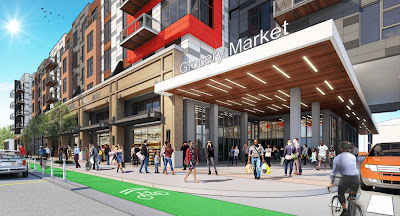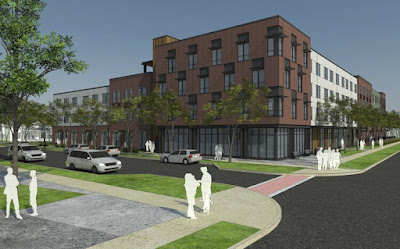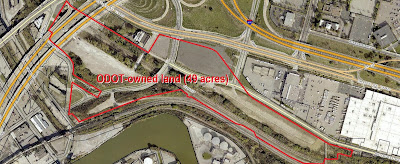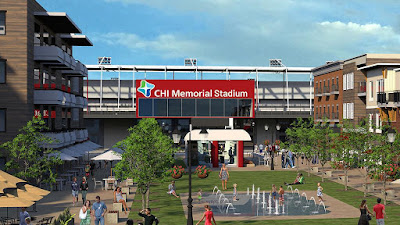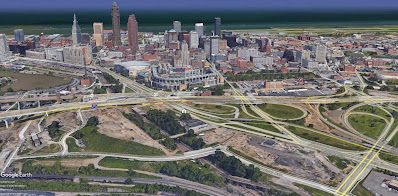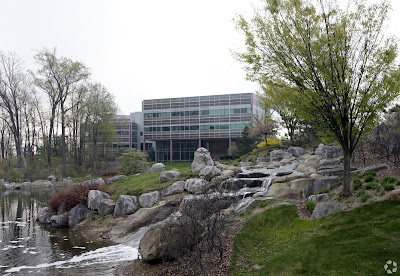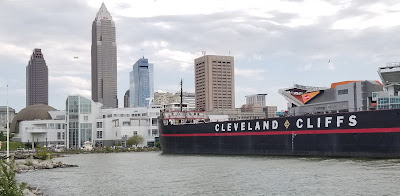UPDATED OCT. 20, 2020
As first reported here at NEOtrans, a Meijer's grocery store topped by market-rate apartments is proposed to be built on East 105th Street near the Cleveland Clinic. However, the location is a bit different than what was previously reported.
It is one of many residential, commercial and insitutional-related developments planned along a short stretch of East 105th at the northeast end of the $306 million Opportunity Corridor that's due to be completed one year from now.
The first phase of the project by Fairmount Properties LLC is planned to have 250-300 micro-unit apartments, several dozen townhouses, and several hundred parking spaces next to or above a 40,000-square-foot grocery store, according to two sources who spoke off the record. This mix of uses is proposed to rise on 3 acres of land at the southeast corner of East 105th and Cedar Avenue.
The sources also confirmed that the proposed grocery store would be a Meijer (pronounced "mi-yer"). It would be the first from that chain planned for the city of Cleveland. Next year, Meijer will open its first store in Cuyahoga County, a full-size store on the site of a former Kmart in Seven Hills.
Full-size, 200,000-square-foot Meijer stores offer more than groceries -- they have everything from clothing to electronics to furniture. Their smaller, urban-format "Neighborhood Market" stores are limited to grocery items. This would be Meijer's first urban store in Ohio. Michigan-based Meijer plans to build at least six small-format stores in revitalizing Midwest urban neighborhoods by 2021.
According to legislation being introduced to Cleveland City Council, Fairmount has control of the land bounded by East 105th, Cedar, Wain Court and East 103rd Street. However, county records show titles to the properties currently remain with a mix of public and private owners including the city's Land Bank, Cleveland Clinic Foundation, Fairfax Renaissance Development Corp., the Ohio Department of Transportation and three separate individuals. Fairmount has purchase agreements for each.
A second phase of development appears to be planned on the block immediately west, bounded by Cedar, East 103rd, East 101st Street and Wain. According to public records, a certificate of disclosure was filed with the city and issued yesterday for 2176 E. 103rd. Fairmount is listed as that parcel's buyer. Every other parcel in that block is owned by the Land Bank, Fairfax Renaissance or Cleveland Clinic.
Fairfax's long-range neighborhood plan shows East 103rd dead-ending before it intersects with Cedar. That would enable continuous development along the south side of Cedar from East 101st to East 105th.
Fairmount Principal Adam Fishman did not respond prior to publication to two e-mails and a voicemail left at his office seeking more information for this article. Meijer Public Relations Manager Christina Fecher also did not respond to a similar e-mail other than acknowledging she received it.
There are actually two pieces of legislation pending before city council to help finance this development. One is to authorize Director of Economic Development David Ebersole to apply for and accept an Empowerment Zone and/or non-Empowerment Zone federal Department of Housing & Urban Development (HUD) Section 108 loan for an amount up to $9 million to partially finance the construction of the "mixed-use grocery store project."
The amount of HUD Sec. 108 borrowing capacity for a community is five times its latest approved Community Development Block Grant allocation minus any outstanding Sec. 108 loan balances or existing commitments. So as of March 2020, Cleveland could borrow nearly $28 million in Sec. 108 loans.
And, in the 1990s, the Fairfax, Glenville, Hough and MidTown neighborhoods of Cleveland were eligible to receive $177 million in federal Empowerment Zone loans and grants, but not all of the funds were committed.
Previously, Fairmount's proposed mixed-use development was considered for the southeast corner of East 105th and Carnegie Avenue. Survey crews were on site in June. However the Cleveland Clinic-owned property was deemed too small for a single-level, 40,000-square-foot grocery store and would have required a tall building. No part of the neighboring Tudor Arms property owned by Ari Maron would be used for Fairmount's development, as confirmed by Maron.
Instead, the development is proposed for the former site of Calvary Hill Missionary Baptist Church, 2171 E. 103rd St. County records show Cleveland Clinic acquired the land for $1.2 million in 2017 and demolished the 1916-built church. The congregation moved to 2222 North Taylor Rd. in Cleveland Hts., formerly Hope Lutheran Church.
Last winter, Cleveland Clinic organized focus groups of Fairfax residents, property owners and others to determine how develop the southeast corner of its main campus. The suggested uses centered around residential and retail -- notably a grocery store.
“Now that the northern section of Opportunity Corridor is open, we plan to further develop the southeast part of our campus," said the Cleveland Clinic's media relations department to NEOtrans last March. "We look forward to working with our community partners on future opportunities that will help accelerate the Fairfax neighborhood reinvestment plan."
This is not the only residential development planned for this stretch of East 105th, within walking distance of the Cleveland Clinic and other employers in University Circle -- Ohio's fourth-largest employment district.
One block south of Fairmount's planned development, at 2258 E. 105th, Fairfax Renaissance plans to hold a groundbreaking ceremony early next month for the first phase of the Innovation Square mixed-income apartment building, according to the Dodge Reports. A specific date hasn't been announced.
However, the online construction project database says actual earthmoving on the site won't begin until spring 2021. Dodge Reports also says Fairfax Renaissance will announce the name of the project's general contractor at the goundbreaking ceremony -- an unusual move. The Ohio Housing Finance Agency's project brief shows the Ozanne Construction Co. of Cleveland as the project's general contractor.
Fairfax Renaissance Executive Director Denise Van Leer did not respond to an e-mail seeking more information prior to publication.
The $12.75 million first phase of Innovation Square will feature 85 apartments on four floors. Of those, 41 units will be affordable housing and 44 will be market-rate units with ground-floor commercial space. It will also have a rooftop deck with a residents' lounge, fitness rooms, bike storage and repair plus electric car charging stations.
Eventually, among all three phases, Innovation Square will offer 223 apartments north and south of Hudson Avenue once it is extended west of East 105th. The new street will extend past the north edge of the new Playwright Park to East 100th Street, according to the neighborhood's masterplan.
Surrounding the park, from East 97th to East 105th, Knez Homes has begun building dozens of single-family houses that will total a $12 million investment, according to Dodge. The housing will be an easy walk to the Cleveland Clinic in one direction and the newly expanded East 105th-Quincy train station in the other. And if Fairmount's development is built, residents of Innovation Square will be a short walk from its grocery store as well.
A few blocks farther north, the massive Circle Square development is due to start construction in March 2021. There, up to 800 apartments, 104,000 square feet of neighborhood retail, 171,000 square feet of office space, nearly 800 structured parking spaces and a future hotel are planned. It is due to start with two apartment buildings -- one 11 stories tall and the other 24 stories. The latter would be University Circle's tallest building.
Commercial and institutional developments are also moving forward on the eastern and southern edges of Cleveland Clinic's campus. Under construction at 10300 Cedar is the 21,000-square-foot Brooks BioRepository. It will enhance researchers’ study of human tissue samples and advance personalized medicine for an array of conditions -- including cancer, heart disease and epilepsy.
Cleveland Clinic has two major projects on its main campus that are moving forward again after being put on hold during much of the COVID-19 pandemic. First will be a 100,000-square-foot expansion of the Cole Eye Institute on East 105th, between Euclid and Carnegie. Then, a new 400,000-square-foot Neurological Institute will rise on Euclid Avenue between East 96th and East 100th streets.
Tyler Kapusta contributed to this article
END

